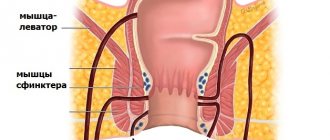For foreign citizens we offer a preliminary free consultation
Leading specialists of the Center will answer your questions.
To get a consultation
Find out the price
The rectum is the most terminal section of the digestive tube. It is a continuation of the large intestine, but in its anatomical and physiological features it differs significantly from it.
The fact that a pathological process is taking place in the final section of the intestinal tube is indicated by the appearance of polyps, adenomas, and inflammatory foci. , rectal cancer develops against their background . Treatment for this disease is usually successful, as the disease has been well studied. Even if it is neglected, a cure is possible if the therapy is carried out by qualified experienced oncologists.
According to world statistics, almost 800 thousand people are diagnosed with colorectal cancer every year. It ranks 4th in the global ranking of cancer diseases.
The disease most often occurs in patients living in developed countries. Their stable economy leads to a decrease in people's physical activity, and this leads to a high risk of developing obesity - and, as a result, to colon cancer. For example, in the USA, 145 thousand people are diagnosed with colorectal cancer every year.
In Belarus, rectal cancer most often affects men and people over 45, especially after 75 years.
Bleeding as an important symptom
Anal bleeding is an important symptom
The sudden spontaneous disappearance of bleeding from the anus is not a reason for peace, since this is a temporary condition before a re-exacerbation of the disease. But this quiet time can complicate treatment or make a positive outcome of the disease impossible.
Based on the color of the bloody discharge, a preliminary conclusion can be made about its origin. Bleeding can occur from any part of the digestive tract, and the higher the organ is located (esophagus, stomach), the darker the color of the blood.
This fact is explained by the effect of digestive enzymes on the hemoglobin of red blood cells, which changes the color of the blood from scarlet to dark brown or black. An exception to this rule may be the presence of a symptom such as diarrhea, in which the blood released into the intestinal lumen does not have time to darken due to its accelerated passage.
Symptoms of colorectal cancer
The insidiousness of this disease is that the disease develops without symptoms for a long time. Therefore, a person should be alert to the following warning signs:
- changes in the nature of bowel movements (slow defecation, diarrhea, flatulence, false urges, “ribbon-like stools,” excessive gas formation, etc.);
- poor health (lack of appetite, low performance, loss of strength, regular attacks of pain in the abdomen, weight loss);
- blood, mucus in stool.
These signals indicate possible problems with the intestines, namely the possibility of a disease such as rectal cancer. Symptoms for which treatment should begin with an examination may indicate a progressive process.
If the disease progresses, its signs are:
- anemia
- presence of fluid in the abdominal cavity
- purulent impurities in stool
- intestinal obstruction
- severe attacks of pain
Symptoms of oncology can include feelings of discomfort and heaviness. It is better to treat rectal cancer at the initial stage, then a complete cure is possible.
Risk factors in the development of colorectal cancer
There are several causes of the disease:
- Nutritional features. The more animal fats, alcohol, and red meat a person consumes, the higher the risk of developing malignancy. The development of the disease is aggravated by the absence or small amount of calcium in the diet, plant foods rich in fiber, as well as vitamins D and C. The sedentary life of a modern person and excess nutrition lead to pathology in the intestines.
- Heredity. Among genetic factors, experts consider two syndromes to be important: FAP (familial adenomatous polyposis) and HNPTC (hereditary nonpolyposis colon cancer). If there have been similar diagnoses in your immediate family, regular preventive examinations are important, since hereditary predisposition increases the risk of malignancy.
- Diseases of the colon (presence of polyps, colitis, Crohn's disease, adenomas, inflammatory processes, etc.). If such diagnoses are present, patients should regularly undergo appropriate examinations to avoid the development of cancer. Patients with polyps should pay special attention to the examination, as they tend to degenerate into a cancerous tumor.
- The causes of tumors include unhealthy habits (drinking alcohol and smoking). They weaken the immune system and can provoke (if there is a predisposition to cancer) the appearance of a tumor in the intestine. Immunodeficiency is also a risk factor.
- Malignant tumors in the mammary glands and genitals of women can cause the development of intestinal cancer.
- Patients 50 and older. Rectal cancer is often found in older people.
Causes of fistulas
If you experience symptoms characteristic of a rectal fistula, in the vast majority of cases the cause for this was an inflammatory process in the anal gland (Fig. 2). In turn, inflammation of the gland is usually preceded by microtrauma of the anal canal. The cause of such injury is most often excessive irritation and/or trauma to the anal canal when too hard stool passes through the anal canal during constipation or, conversely, during diarrhea. Relatively rare causes of so-called specific fistulas of the anal canal and rectum are inflammatory bowel diseases (Crohn's disease, ulcerative colitis), tuberculosis, rectal tumors, and the consequences of radiation therapy of the pelvic organs. Inflammation of the gland is accompanied by the development of an abscess (ulcer) in the soft tissues of the perineum and is usually characterized by severe pain, which forces the patient to consult a doctor. Timely and correctly performed opening of the abscess leads to rapid relief of the condition, however, according to modern data, about half of all abscesses are accompanied by the subsequent formation of a fistula and require repeated intervention.
It is this repeated intervention that is aimed at radically getting rid of the fistula and requires not only an extremely thoughtful approach to the choice of treatment tactics, but also extensive surgical experience on the part of the surgeon.
Important! Opening an abscess is a relatively simple operation, but if performed incorrectly, it is at this stage that the muscular complex of the anal canal is most often damaged, which leads to disruption of the function of controlling intestinal contents!
If your visit to the doctor is postponed, the abscess may open on its own with the release of pus, after which your health usually improves and the pain in the perineal area decreases sharply. Symptoms may subside or disappear completely for a period of several weeks or months to many years. Despite the improvement in general well-being, spontaneous opening of an abscess is a relatively unfavorable scenario, because in this case, there is no complete evacuation of the contents of the purulent cavity, but only part of the purulent discharge occurs through the formed hole, which can soon close again. Proper treatment of an abscess consists of creating adequate drainage by creating a sufficient hole, evacuating the contents, rinsing the abscess cavity with antiseptic solutions and, if possible, removing the inflamed gland that is causing the inflammation.
Important! Sometimes, in the hands of an expert surgeon, with the relative simplicity of the fistula tract, radical excision of the fistula at the stage of surgical opening of the abscess is possible, but performing this intervention is extremely dangerous in the hands of an insufficiently experienced specialist and today is not recommended in most international recommendations.
When an abscess spontaneously opens, the likelihood of a return of the acute disease increases and the process becomes chronic with the formation of a fistula. A long course of the disease with periodic exacerbation leads to scarring of the surrounding tissues and, most importantly, the sphincter muscles responsible for the holding function. In addition, in conditions of constant inflammation, a relatively simple fistula can give rise to additional passages and leaks, which significantly complicates subsequent treatment.
Timely consultation with a doctor at an early stage of the disease can reduce the likelihood of developing a fistula and such dangerous complications of the inflammatory process as pelvic phlegmon. Therefore, even minor symptoms that do not significantly affect the quality of life require attention and evaluation by a qualified specialist.
How is the stage of colorectal cancer determined?
There are four stages – I, II, III, IV. In some classifications, zero is also taken into account.
Rectal cancer: stages, treatment
Zero (pre-invasive cancer) stage.
It is asymptomatic. At this phase of the development of the disease, the patient is bothered by a feeling of heaviness and constipation. The tumor is often discovered by chance during palpation or during rectoscopy or colonoscopy. The tumor is small, cancer cells are removed through surgery - and no further treatment is required.
Stage I (invasive cancer).
The tumor is small in size (up to 2 cm), penetrated into the layers of the intestinal wall, but did not go beyond its borders. There are no metastases and therefore oncologists most often perform surgery.
Stage II.
The disease extends beyond the boundaries of the intestine, but the tissues around the organ are not affected by metastases. Treatment is surgical.
Stage III.
Metastases have penetrated into nearby lymph nodes, but have not penetrated into distant ones. Treatment must be combined. Today, oncologists practice radiation and/or chemotherapy before and after surgery.
Stage IV.
Organs and/or lymph nodes distant from the intestine are affected by cancer cells. Treatment methods depend on the area of spread of metastases:
- combined extensive surgery + further chemotherapy;
- preoperative chemotherapy—removal of tumors, metastases—massive chemotherapy;
- chemoradiation preoperative treatment–surgery–potent postoperative chemotherapy. One of the main goals of doctors at this stage is to prolong the patient’s life and improve its course.
Diagnosis of rectal cancer
To detect colorectal cancer in a timely manner, modern medicine uses various types of diagnostics:
- Digital rectal examination.
- Occult blood test (hemoculture test).
- Colonoscopy.
- Ultrasound (ultrasound examination).
- Tumor markers.
- MRI (magnetic resonance imaging).
- Sigmoidoscopy.
- PET (positron emission tomography).
- Rectoscopy.
- CT (computed tomography).
The simplest method is a rectal examination using fingers. The specialist can feel the formations in the intestine with his index finger, assess their nature and take a biopsy.
If rectal cancer is suspected, diagnosis continues. The stool is examined for the presence of occult blood. If it is detected, the patient is referred for a colonoscopy.
This method is the only and most informative way to verify the presence of a tumor in the rectum. An endoscope is inserted into the anus to examine the inner surface of the intestine, previously cleansed with an enema or laxatives. During the procedure, the doctor not only takes tissue samples, but may also remove any polyps found.
When performing a colonoscopy, a specialist can examine the sigmoid colon (sigmoidoscopy) or rectum (rectoscopy).
During an ultrasound, the organ is examined using an ultrasound probe. This examination allows you to find out how far the tumor has penetrated the intestinal wall, whether there are neoplasms in neighboring tissues, or metastases in the lymph nodes.
Tumor markers make it possible to determine the degree of activity of tumor cells.
MRI most accurately shows the picture of the presence of tumor processes in the pelvis. This study is mandatory when confirming the need for chemoradiotherapy before surgery.
A PET scan identifies cancer cells, which are made visible by special agents administered intravenously.
CT scans use contrast agents to help visualize malignant neoplasms in the rectum, as well as detect organs affected by metastases.
Useful tips for gastrointestinal bleeding
- toilet paper for anal bleeding should have a soft and smooth structure so as not to injure the anal area, which can cause bleeding in the case of anal fissure and hemorrhoids;
- the use of toilet paper should be done with extreme caution, without unnecessary pressure on the anus, so as not to injure the area where the fissure or hemorrhoid is located;
- Untrimmed fingernails can also become a traumatic factor for the affected area.
- in addition, bleeding areas are entry points for infection and failure to comply with hygiene rules and constant trauma to the anal area threatens the occurrence of complications such as inflammation of the hemorrhoid or paraproctitis, which are already acute surgical pathologies and require immediate intervention by a proctologist or surgeon;
- to reduce the traumatic effects of feces during defecation, it is justified to use emollients based on petroleum jelly or another similar substance, which are applied immediately before defecation to the anus;
- It does not hurt to be careful and attentive while eating, especially for people with diseases manifested by gastrointestinal bleeding, since any object that cannot be digested in the gastrointestinal tract, or even unchewed food, can become a traumatic factor and cause bleeding;
- drinking a large amount of liquid prevents the formation of feces of a solid consistency, thereby eliminating the factor of trauma when passing through the anus. The recommended minimum amount of fluid to drink is 2 liters per day.
- Eating foods high in fiber plays a positive role in reducing the factors of trauma to the anus. This group of food products includes vegetables and fruits, dishes made from legumes and unground cereals. When consuming these products, the consistency of stool becomes elastic and soft, which facilitates its unhindered passage through the anus.
If, after observing all the listed precautions, bleeding from the anus has stopped, then you should still not neglect visiting a doctor, since the task of medicine is not only to eliminate the symptom, but also to find out its origin and cure its root cause, thereby preventing recurrence of bleeding.
Treatment methods for colorectal cancer
- Surgery
- Chemotherapy.
- Radiation therapy.
- Combination of methods.
Surgery
If the tumor affects the submucosal or mucous layers of the intestine, only surgical intervention is performed. If the rectal cancer is small, it is removed using a colonoscope through the anus.
When surgery for rectal cancer is performed by highly qualified oncologists and special equipment is available, the tumor can be removed using transanal endomicrosurgery.
If the tumor penetrates into the muscle layers, surgery is performed with complete or partial excision of the affected area.
A combined operation is prescribed when tumor cells spread to nearby organs. The operation is carried out in a single block. In case of invasion of metastases into the ovaries, lungs, liver, etc., the issue of their stage-by-stage or one-stage resection is decided at a medical consultation.
Radiation therapy
If the tumor has grown through all layers of the intestine or metastases are found in nearby lymph nodes, radiation therapy is used before its removal. 5 days – in Belarus, this is the duration of the course of exposure to a tumor using ionizing radiation (short course), followed by surgery on days 0–5 after the end of irradiation.
If a locally advanced tumor is detected in the rectum, the patient is treated for one to one and a half months through chemoradiotherapy, followed by a decision on surgical treatment.
Chemotherapy
This method of treatment is used for widespread tumor processes, stages 3 and 4 of the disease. Chemotherapy is prescribed both in isolated form and in combination with radiation therapy (chemoradiotherapy) before and after surgery.
After tumor removal in stage 3 colon cancer, additional chemotherapy sessions are carried out that are preventive in nature.
Dispensary observation
To avoid relapse of the disease, the patient is under clinical observation for the first two years. This is necessary in order to timely detect new polyps, which often arise in patients after surgery.
The purpose of dispensary monitoring is to exclude the development of a recurrent disease. For 2 years after the operation, the patient must visit an oncologist every 6 months and undergo examinations prescribed by the doctor, and if complaints arise, undergo an extraordinary examination. If a relapse of the disease is detected early, the patient has a good chance of successful treatment.
What is the likelihood of the disease returning?
The risk of disease relapse with complex, high fistulas is slightly higher than with simple intrasphincteric fistulas and depends on the type of fistula, its location, and the presence of previous surgical interventions. Treatment of recurrent fistulas is a particularly difficult task for a coloproctologist. Previous operations on the anal canal create gross cicatricial deformities, changing the anatomy and significantly impairing the function of retention, and a long course of the disease or inadequate previous treatment can lead to the formation of additional streaks and passages. In such conditions, planning of surgical intervention should be carried out after a full examination.
The success of the upcoming surgical intervention largely depends on a comprehensive assessment of the available data using various diagnostic methods and a mandatory conversation with the surgeon. An important factor is also the implementation of surgical intervention in a specialized hospital, where this type of treatment is based on world research data, their own many years of experience and is carried out by specialists who have successfully completed training and courses to improve their skills in treating this disease.
Important! The skill of a coloproctologist is judged all over the world by the ability to correctly operate anorectal fistulas, since since the existence of proctology, the treatment of fistulas has been and is now perhaps the most difficult section of diseases of the anorectal zone!
How to prevent colorectal cancer?
Rectal cancer can be avoided. The disease develops in the presence of long-existing polyps. Their appearance is asymptomatic, so in order to detect these benign formations in time, people after 45 years of age need to undergo a colonoscopy.
If during the examination the doctor finds polyps in the patient, he will be able to remove them painlessly. After such removal, the patient should undergo a colonoscopy annually to prevent the development of new polyps.
If no formations in the rectum are detected, colonoscopy can be repeated after 10 years. In the interval between these examinations, it is enough to do a blood culture test for occult blood from time to time.










